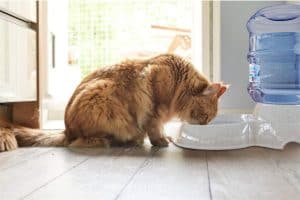Cats have a reputation for being skittish around water bottles, but have you ever wondered why? Let’s explore the reasons behind why cats are afraid of water bottles.
The Evolutionary Explanation
Cats’ aversion to water bottles can be linked to their evolutionary history as desert-dwelling animals. In the wild, water sources were scarce, and encountering large bodies of water could pose a threat to their survival. Thus, cats developed a natural instinct to be cautious around water to avoid potential dangers. This innate fear may manifest when they see a water bottle, which could resemble a larger body of water in their eyes. The sound of water sloshing inside the bottle may also trigger their instinctual response to steer clear of potential hazards. So, next time your feline friend scurries away at the sight of a water bottle, remember it’s simply their primal instincts kicking in.
The Startling Sound
The crinkling sound of a water bottle may be a key factor in why cats are afraid of them. Cats have highly sensitive hearing, allowing them to detect even the faintest of noises. The sudden and unexpected noise of a water bottle being squeezed or crunched can startle them and trigger a fight-or-flight response. This reaction stems from their wild ancestors’ need to stay alert to potential threats in their environment. The sharp, unfamiliar sound of a water bottle being manipulated may remind cats of potential dangers lurking nearby, prompting them to react defensively or seek safety. So, it’s not just the sight of the water bottle that scares them but also the unexpected sound it produces.
Additional Insight: Cats’ sensitivity to sound extends to all kinds of noises, not just the crinkling of water bottles. Loud or sudden sounds can startle cats and cause stress, so it’s essential to create a calm and quiet environment for your feline companion.
Negative Associations
Negative experiences with water bottles, such as accidental sprays or harsh discipline, can contribute to a cat’s fear. Cats have excellent memories and can associate the sound or sight of a water bottle with past unpleasant encounters. To help your cat overcome this fear, try replacing the negative associations with positive experiences by offering treats or playtime near the water bottle. Gradually reintroduce the water bottle in a non-threatening way to show your cat that it is not always a cause for alarm.
Sensory Sensitivities
Cats have heightened senses, including sensitive ears, which can make the sound and movement of a water bottle overwhelming for them. The crinkling noise of the bottle and the sudden squirt of water can be startling to a cat’s delicate senses. To help your cat feel more comfortable around water bottles, try using a quieter, non-threatening alternative for positive reinforcement. Additionally, consider incorporating interactive play or gentle petting near the water bottle to create positive associations and desensitize your cat to its presence.
Additional Insight: It’s essential to remember that each cat is unique, and their fear of water bottles may stem from different reasons. Take the time to observe your cat’s behavior and reactions to pinpoint the specific triggers causing fear. By understanding your cat’s individual sensitivities, you can tailor your approach to help them overcome their fear more effectively.
Natural Prey Response
Have you ever noticed how your cat gets skittish around water bottles? It might be because the unpredictable movement and shape of a water bottle can resemble the behavior of prey animals. Cats are natural hunters, so when they see something that mimics the movements of a potential prey, their hunting instincts kick in. The twitching of a water bottle or the way it rolls on the ground can trigger their predatory response, making them feel on edge and hesitant around it.
Behavioral Conditioning
Over time, cats can develop a fear of water bottles through behavioral conditioning. If a cat has had negative experiences with water bottles in the past, such as being sprayed with water as a training method or being startled by the sound of a bottle falling, they may associate water bottles with fear and avoidance. This conditioning can cause them to react defensively or anxiously around water bottles, even if there is no real threat present.
Unique Insight:
- Create positive associations with water bottles by incorporating them into playtime or feeding routines. This can help counteract any negative conditioning and show your cat that water bottles are not something to be feared.
Protective Instincts
Cats are known for their strong protective instincts and preference for control over their environment. When faced with unfamiliar objects like water bottles, these instincts can kick in, causing fear or anxiety. Cats may perceive water bottles as a potential threat or disruption to their surroundings, leading them to avoid or even exhibit fear towards these objects. By understanding and respecting these instincts, cat owners can help create a safe and comfortable environment for their feline friends.
Alternative Deterrents
Instead of relying on water bottles to deter unwanted behaviors in cats, there are alternative methods that can be just as effective without instilling fear or anxiety in your pet. For example, using positive reinforcement techniques like clicker training or rewarding good behavior can help encourage desired actions while avoiding the negative associations that may come with using water bottles. Providing appropriate scratching posts, toys, and interactive play sessions can also help redirect your cat’s energy in a positive way. Additionally, consulting with a veterinarian or animal behaviorist can provide personalized strategies for addressing specific behavior challenges in a positive and constructive manner.
Additional Tip : Consider using pheromone diffusers or sprays, such as Feliway, to help reduce stress and anxiety in your cat, which can contribute to unwanted behaviors.
Fun Facts about Cat Behavior
Let’s dive into some cool cat behavior facts that might help explain why those furry friends of ours have a unique fear of water bottles:
Territorial Nature : Cats are incredibly territorial creatures, and anything new or unfamiliar can trigger their sense of threat. The unknown sound or movement of a water bottle can spark their instinct to be cautious or even fearful.
Sensitive Hearing : Cats have ultra-sensitive hearing, making even subtle sounds like the crinkle of a water bottle extremely loud and startling for them. This heightened sensitivity can amplify their fear response, causing them to avoid water bottles altogether.
Association with Punishment : Cats are smart animals and can quickly associate certain objects or sounds with negative consequences. If a water bottle was ever used to discipline a cat in the past, they might develop a fear of it due to this negative association.
Prey Instincts : Cats are natural hunters, and the sudden spray or squirt from a water bottle can confuse their prey instincts. They may perceive the water bottle as a threat or predator due to the unexpected burst of water, triggering their fear response.
Texture Sensitivity : Cats are known for their sensitivity to textures, and the cold, smooth surface of a water bottle can feel unnatural and uncomfortable to them. This sensation might contribute to their fear or aversion towards water bottles.
The next time you catch your cat eyeing that water bottle warily, remember these fun facts about cat behavior that shed light on their unique reactions. Understanding their instincts and sensitivities can help create a safe and comfortable environment for your feline friend.
Alex, a passionate animal lover, has experience in training and understanding animal behavior. As a proud pet parent to two dogs and three cats, he founded AnimalReport.net to share insights from animal experts and expand his knowledge of the animal kingdom.




